MARIANI’S
December 7, 2008
NEWSLETTER
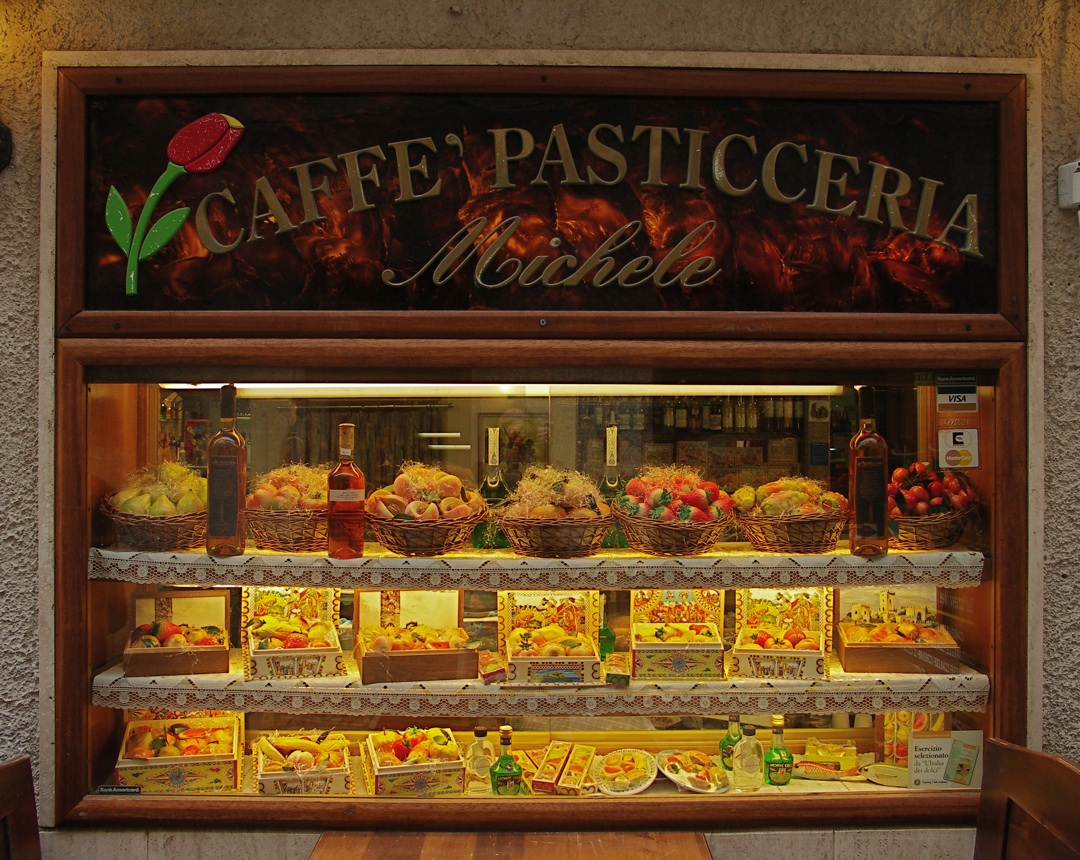
Holiday Pastries, Erice, Italy (2008) by Galina Stepanoff-Dargery
NEW! Click esquire.com
to go to my new column at Esquire Magazine.
ARCHIVE: Readers may now access
an
Archive of all past newsletters--each annotated--dating back to July,
2003, by simply clicking on www.johnmariani.com/archive
SUBSCRIBE AND
UN-SUBSCRIBE: You may subscribe anyone you wish
to this newsletter--free of charge--by
clicking here.
In
This Issue
FOOD AND DRINK BOOKS FOR HOLIDAY GIVING by John Mariani
NEW YORK CORNER: ICON by John MarianiNOTES FROM THE WINE CELLAR: WHITE BURGUNDIES by Brian Freedman
QUICK BYTES
~~~~~~~~~~~
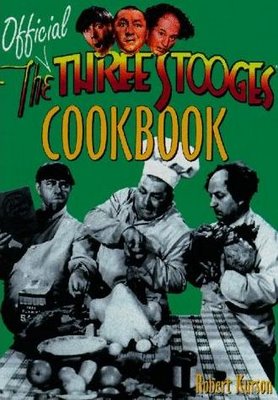 FOOD
AND
DRINK BOOKS FOR HOLIDAY GIVING
FOOD
AND
DRINK BOOKS FOR HOLIDAY GIVING
by
John Mariani
The year-end
holidays have traditionally
been the time when the most cookbooks are sold, some even to people who
intend to cook from them. Many are given as gifts to that friend “who
loves to cook,” others because they will look divine on someone’s new
coffee table.
Since every kind of cookbook on every possible
subject has already been published—and the celebrity chef cookbooks are
lagging these days—the industry must come up with dazzling-looking,
glossy cookbooks or highly authoritative ones or, often, witty takes on
a subject. Having gone through scores of new cookbooks this year,
here are those I believe are well worth cooking from and reading.
(1998
paperback)
________________________________________________
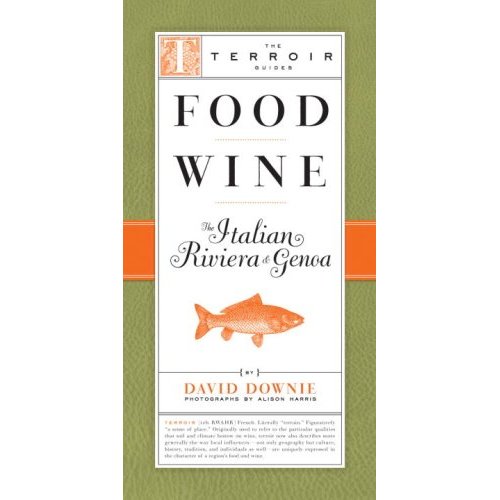 Food
Wine: The Italian Riviera
& Genoa by
David Downie (The Little Bookroom,
$24.95)--Outside of general guidebooks to Italy, few individual
regions have had single volumes dedicated to their gastronomy, and
this, one of a series of "Terroir Guides," is both thorough in its
listings of places to eat and drink, from ristoranti and focaccerie to pasticcerie and chocolate shops, as
it is a well-written depiction of what makes Liguria so very
special--and heretofore underrated--as a territory for wonderful food
and wine, with its rippling, seafood-rich coastline, its famous basil
that goes into making pesto, and its ties to the cooking of Southern
France. Excellent, evocative photos too.
Food
Wine: The Italian Riviera
& Genoa by
David Downie (The Little Bookroom,
$24.95)--Outside of general guidebooks to Italy, few individual
regions have had single volumes dedicated to their gastronomy, and
this, one of a series of "Terroir Guides," is both thorough in its
listings of places to eat and drink, from ristoranti and focaccerie to pasticcerie and chocolate shops, as
it is a well-written depiction of what makes Liguria so very
special--and heretofore underrated--as a territory for wonderful food
and wine, with its rippling, seafood-rich coastline, its famous basil
that goes into making pesto, and its ties to the cooking of Southern
France. Excellent, evocative photos too.
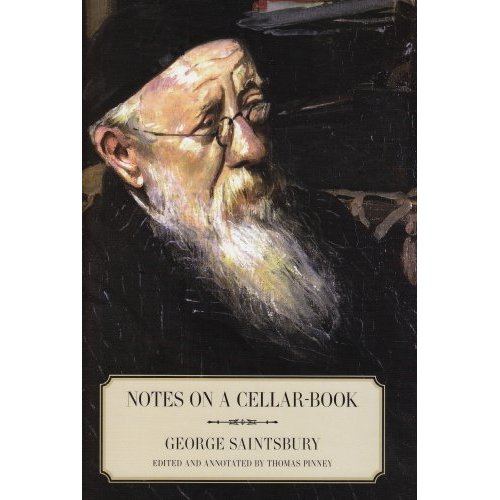 Notes on a Cellar-Book
by
George
Saintsbury (U. of California Press,
$29.95)--For the sheer
pleasure of reading about wine, Notes,
which first
appeared in 1920, has been re-published by the University of California
Press. These very personal, charmingly eccentric notes are as
much a
model for wine writing as they are an historical document revealing how
wines were once regarded and how times have changed. Saintsbury
(1845-1933) was what used to be called a “man of letters,” erudite,
chatty, and given to strong opinions beautifully nuanced, so that he
can write of his era, “It is true there is nothing that some servants
will not break,” noting how his parlor-maid “was evidently well up in
the doctrine of transmission of forces” by arranging decanters and
wineglasses so precariously in a cupboard that she managed to break the
entire contents and the door itself in one quick movement—“a beautiful
demonstration in physics, but I wish it had occurred somewhere else.”
Notes on a Cellar-Book
by
George
Saintsbury (U. of California Press,
$29.95)--For the sheer
pleasure of reading about wine, Notes,
which first
appeared in 1920, has been re-published by the University of California
Press. These very personal, charmingly eccentric notes are as
much a
model for wine writing as they are an historical document revealing how
wines were once regarded and how times have changed. Saintsbury
(1845-1933) was what used to be called a “man of letters,” erudite,
chatty, and given to strong opinions beautifully nuanced, so that he
can write of his era, “It is true there is nothing that some servants
will not break,” noting how his parlor-maid “was evidently well up in
the doctrine of transmission of forces” by arranging decanters and
wineglasses so precariously in a cupboard that she managed to break the
entire contents and the door itself in one quick movement—“a beautiful
demonstration in physics, but I wish it had occurred somewhere else.”
He wrote at a time when dry Champagne was
considered an
uncouth beverage, and he dismisses the romantic notion of the bubbly by
writing, “For my own part, `toujours champagne’ would nauseate me in a
week or less.” It was also a time
when, after a lunch of salmon and beer washed down with a bottle of
Burgundy, a sturdy fellow like Saintsbury thought nothing of shaking
off his woozy indulgence by walking twelve miles back to town.
If ever there were a companion with whom to
sit by a fire
and sip a glass or two of Port, Saintsbury would be one to regale you
until the embers fade or the bottle is empty.
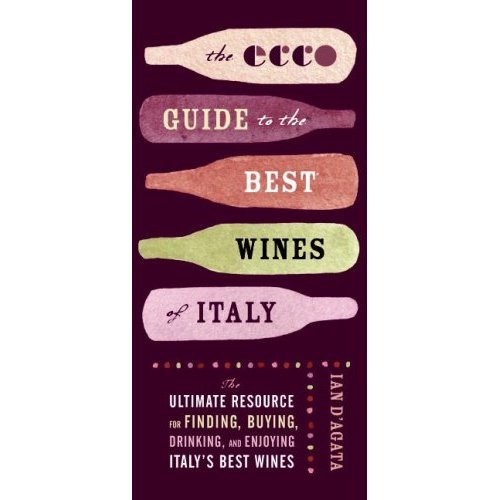 The Ecco Guide to the Best Wines of
Italy by
Ian D'Agata (Ecco, $13.95)--The
subtitle of Ian D’Agata’s new
book, “The Ultimate Resource for
Finding, Buying, Drinking, and Enjoying Italy’s Best Wines” is not in
the least inflated. Not since Joseph Bastianich and David Lynch’s
comprehensive, but now outdated, Vino
Italiano came out in 2005 has
anyone treated the subject in such depth as D’Agata, who runs the
International Wine Academy in Rome and is a man of tremendous knowledge
and enthusiasm for his subject. His modus operandi was “to write a
guide that gives a complete overview of Italy’s best wines, with enough
wines included so that the picture you get is accurate and thorough,
without turning it into a telephone book or an
encyclopedia.”
He breaks the book into three sections: The first, his
choice of the 200 top wines in Italy, all, at the time of writing,
imported into the U.S.; second, more lists, like the best wines at $25
or less; “cult wines”; wines made from native grape varieties, and
more. The last section is concise 37-page discussion of Italian wine
history, culture, varietals, regions, and wine laws—just about all
anyone needs to know on the subject.
The Ecco Guide to the Best Wines of
Italy by
Ian D'Agata (Ecco, $13.95)--The
subtitle of Ian D’Agata’s new
book, “The Ultimate Resource for
Finding, Buying, Drinking, and Enjoying Italy’s Best Wines” is not in
the least inflated. Not since Joseph Bastianich and David Lynch’s
comprehensive, but now outdated, Vino
Italiano came out in 2005 has
anyone treated the subject in such depth as D’Agata, who runs the
International Wine Academy in Rome and is a man of tremendous knowledge
and enthusiasm for his subject. His modus operandi was “to write a
guide that gives a complete overview of Italy’s best wines, with enough
wines included so that the picture you get is accurate and thorough,
without turning it into a telephone book or an
encyclopedia.”
He breaks the book into three sections: The first, his
choice of the 200 top wines in Italy, all, at the time of writing,
imported into the U.S.; second, more lists, like the best wines at $25
or less; “cult wines”; wines made from native grape varieties, and
more. The last section is concise 37-page discussion of Italian wine
history, culture, varietals, regions, and wine laws—just about all
anyone needs to know on the subject.
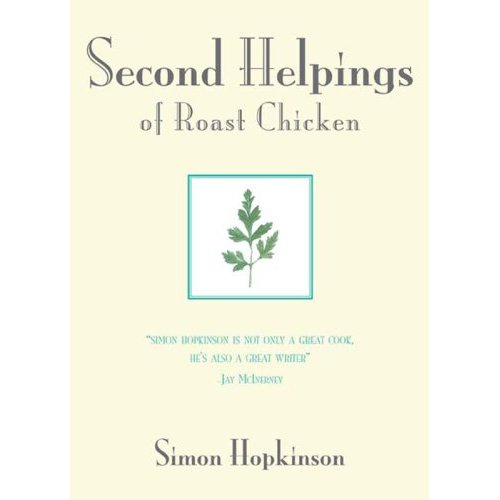
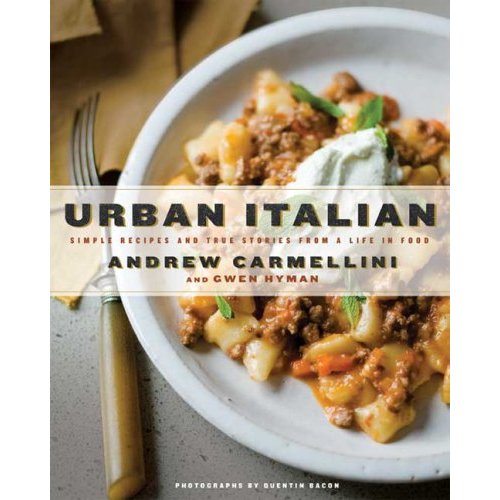

Asian
Dining Rules by Steven
A.
Shaw (Wm. Morrow, $15.95)--Finally,
finally!, someone has
demystified
the often inscrutable ways of eating at Asian restaurants. And
fortunately that someone is the ebullient happy eater Steven Shaw, aka
"The Fat Guy" who runs the eGullet website. He dispels myths on
almost every page ("Only at the very best Japanese restaurants do you
get real wasabi, which must be freshly grated."), and gives you great
hints like getting a table near the kitchen at a dim sum restaurant
when the freshest, hottest dim sum comes out first. He gives
hints on "barbecue mistakes to avoid" at Korean restaurants, why "the
cheapness of Asian cuisines has been a blessing and a curse," and why
going to a Chinese restaurant without a Chinese-speaking friend is
pretty useless if you want the real thing. For sixteen bucks, this will
save you both money and angst.
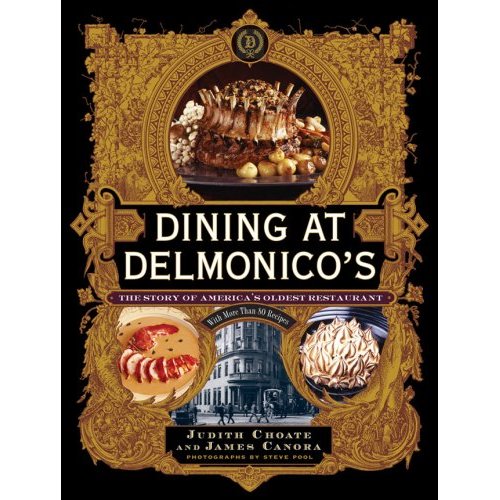

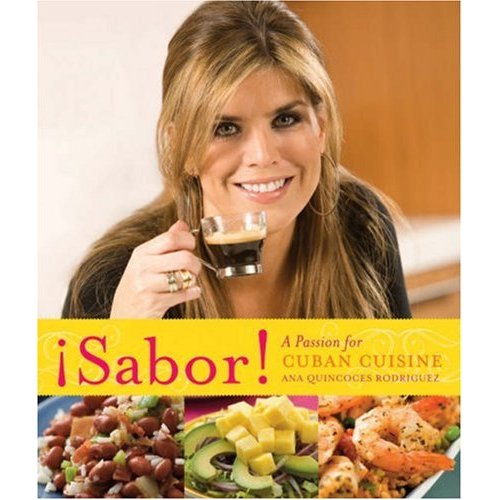 ¡Sabor!
A Passion
for Cuban Food
by Ana Quincoces Rodriguez (Running
Press, $29.95)--O.K., the book has
the decidedly contrived look of an attempt to launch a campaign to get
a
very pretty woman into the celeb food chain, maybe her own TV show? And
her perky comments seemed designed for sound bites. Nevertheless, the
recipes are not only sound but true to the Cuban food culture,
modernized just enough to make them well worth trying in the home
kitchen with easy access to just about every ingredient.
¡Sabor!
A Passion
for Cuban Food
by Ana Quincoces Rodriguez (Running
Press, $29.95)--O.K., the book has
the decidedly contrived look of an attempt to launch a campaign to get
a
very pretty woman into the celeb food chain, maybe her own TV show? And
her perky comments seemed designed for sound bites. Nevertheless, the
recipes are not only sound but true to the Cuban food culture,
modernized just enough to make them well worth trying in the home
kitchen with easy access to just about every ingredient.
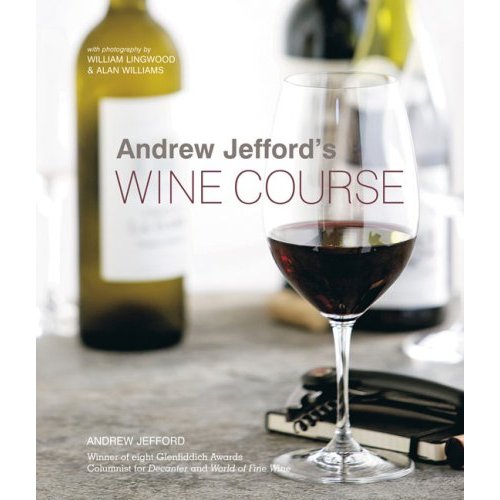 Andrew
Jefford’s Wine Course by Andrew Jefford (Ryland Peters
& Small, $29.95) is very attractive, well photographed, and
a decent
price. Jefford is a columnist for Decanter Magazine, and from
the very first pages he puts his subject into admirable perspective:
“Our love of wine is in part a love for the earth itself. . . . The
drawback to this small universe of differences is that wine is
necessarily complicated. Dozens of countries, tens of thousands of
producers, all of them producing a new vintage every year: this is
something that cannot be simplified.” But, in 20 “Projects”
with
titles like “How to Taste,” “Grapevines: Meet the Family,” and “The
Human Role,” Jefford does the best he can to make wine approachable
and fascinating, with just enough info to help the tyro understand
everything from texture in a wine and why terroir matters to the
characteristics of varietals (he calls merlot “the most carnal of the
world’s red wines” and syrah “the wine world’s greatest actor, capable
of extraordinary transformation”).
Andrew
Jefford’s Wine Course by Andrew Jefford (Ryland Peters
& Small, $29.95) is very attractive, well photographed, and
a decent
price. Jefford is a columnist for Decanter Magazine, and from
the very first pages he puts his subject into admirable perspective:
“Our love of wine is in part a love for the earth itself. . . . The
drawback to this small universe of differences is that wine is
necessarily complicated. Dozens of countries, tens of thousands of
producers, all of them producing a new vintage every year: this is
something that cannot be simplified.” But, in 20 “Projects”
with
titles like “How to Taste,” “Grapevines: Meet the Family,” and “The
Human Role,” Jefford does the best he can to make wine approachable
and fascinating, with just enough info to help the tyro understand
everything from texture in a wine and why terroir matters to the
characteristics of varietals (he calls merlot “the most carnal of the
world’s red wines” and syrah “the wine world’s greatest actor, capable
of extraordinary transformation”).
NEW YORK CORNER
by John Mariani
ICON
W Hotel
130 East 39th Street (near Lexington Avenue)
212-592-8888
www.iconrestaurantnyc.com
The W Hotel chain has been aiming at a youth market for some time now, and the problem is that youth (i..e., 20-35) tires quickly of programmed hot spots and furnishings, but W tries to keep things hip, sleek, and swanky.
That means a sexually charged Randy Gerber-conceived Wet Bar, music pumped into the dining room, and a casual approach to everything. In the case of Icon, this means red velvet, shiny surfaces, and a play of bright light and deep shadows; in other words, a typical W design, flashy but soon to look dated.
Despite this, the cuisine of chef Michael Wurster (below), a New Yorker with experience at Lutèce, Le Cirque, The French Laundry, and Eleven Madison Park, is an impeccably crafted testament to his solid training, so that his technique is evident, his ideas his own, and his respect for ingredients sound. And with a $66 six-course tasting menu available, he is serving one of the great bargains in Manhattan for food of a high caliber. The prices à la carte, though, are on the high side, with appetizers $12-$16 and entrees $22-$39. Portions are pretty generous.
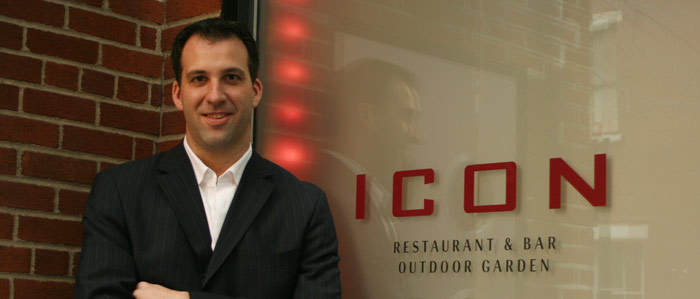 Right
off the bat I was impressed with his crispy duck confit with basil
mustard, micro greens, raisin paper, and lavender smoke--a dish that
just skirts being overwrought by putting everything on the plate into
subtle equilibrium. Equally delicious was his creamy, rich terrine of
foie gras with sweet Concord grapes, gewürztraminer, spiced bread
and licorice greens--pulsating sweet, salty, meaty, vegetable flavors
working well together. A wild mushroom risotto with a touch of thyme
and laced with mascarpone and Parmesan was straightforward and
luscious, and there was both wit and savoriness in chicken lollipops (below) done like Buffalo-style
wings, here served with Maytag blue cheese and celery--perhaps not a
big improvement on a bar favorite but fought over at our table
nonetheless. The only disappointment among the
appetizers was a dish of Nantucket bay scallops that were sadly fishy,
served with too much else on the plate--truffled potatoes, Guinness, a
poached egg and romaine lettuce hearts.
Right
off the bat I was impressed with his crispy duck confit with basil
mustard, micro greens, raisin paper, and lavender smoke--a dish that
just skirts being overwrought by putting everything on the plate into
subtle equilibrium. Equally delicious was his creamy, rich terrine of
foie gras with sweet Concord grapes, gewürztraminer, spiced bread
and licorice greens--pulsating sweet, salty, meaty, vegetable flavors
working well together. A wild mushroom risotto with a touch of thyme
and laced with mascarpone and Parmesan was straightforward and
luscious, and there was both wit and savoriness in chicken lollipops (below) done like Buffalo-style
wings, here served with Maytag blue cheese and celery--perhaps not a
big improvement on a bar favorite but fought over at our table
nonetheless. The only disappointment among the
appetizers was a dish of Nantucket bay scallops that were sadly fishy,
served with too much else on the plate--truffled potatoes, Guinness, a
poached egg and romaine lettuce hearts.Still, fat, creamy sea scallops "black tie" was a noble homage to the famous creation of Chef Daniel Boulud when he was chef at Le Cirque, the mollusk layered with black truffles and braised bacon with endive and shallots. Monkfish "surf and turf" came with wonderful osso buco-stuffed ravioli, pea shoots, fennel pollen and a mustard sauce, the monkfish itself of good, tender quality. Crispy veal breast was not all that crispy, but it had good flavor enhanced by a polenta cake, baby beets and carrots.
Just about everybody is serving pork in myriad forms these days, and Wurster does it as a "suckling pig quartet," with braised belly with sour apple "pop rocks" (not bad actually); 12-hour roasted loin with figs, raisins, pinenuts and cabernet vinegar (very good); basil-scented sausage with butterscotch (nice idea), and shoulder with pearl onions and smoked bacon bits (wonderful). The real problem with the dish was that the pig's skin, which should crunch in your mouth, was so tough I could barely saw through it with my knife.
Two desserts won out--a "72% Chocolate `Kit Kat' bar with layers of praline and a happy-making root beer float, and a plate of cinnamon donuts with a "black & white" (chocolate and vanilla) shake--over a cloyingly sweet "Snickers" bar with frozen nougat, peanut butter sauce and chocolate ice cream.
Wurster is definitely a chef I'll keep an eye on in the future. So should you. For now he's doing terrific work, albeit in a place that doesn't quite seem serious enough for his talents.
Icon is open for breakfast, lunch and dinner daily.
~~~~~~~~~~~~~~~~~~~~~~~~~~~~~~~~~~~~~~~~~~
NOTES FROM THE WINE CELLAR
WHITE BURGUNDIES
by Brian Freedman
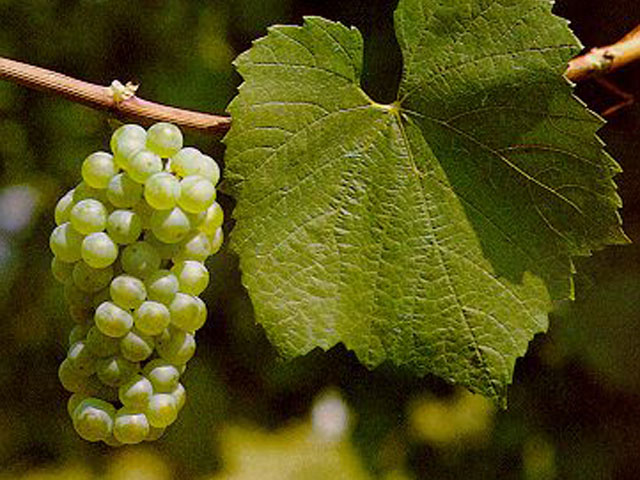 With
wine, it’s easy to get caught up
in the vagaries of style, specifically in the latest tendency to
stress, say,
super-ripe fruit, or aggressive oak, or any of a hundred other vineyard
and winery decisions that ultimately determine the nature of the juice
in the bottle.
With
wine, it’s easy to get caught up
in the vagaries of style, specifically in the latest tendency to
stress, say,
super-ripe fruit, or aggressive oak, or any of a hundred other vineyard
and winery decisions that ultimately determine the nature of the juice
in the bottle.
But the best white Burgundy, in so many ways, is
different. Like the most revered wines around the world, these
chardonnays manage to maintain a sense of both idiosyncrasy and
predictability, which is not an easy trick to pull off. In that regard,
they remind me, oddly enough, of the reds of Priorat, where the land
itself comes through with a clarity that verges on the startling.
What makes good white Burgundies even more miraculous, though, is the
fact that they don’t have the advantage of blending to pick up slack
where it might be needed. They are, in the end, profound
expressions of
a specific place in a specific year, much like the best rieslings from,
say, the Mosel.
Chardonnay
Grapes
Regarding that sense of place,
there are few
regions in the world where the minute differences of soil, aspect,
drainage, etcetera are as intricately mapped out and understood as they
are
in the Côte d’Or. Vineyards right next to each other, even
adjacent parcels within the same plot of vineyard land, often manifest
themselves in profoundly different ways through either the chardonnay
or pinot noir planted on them.
The downside of this deep-level understanding
of the land in the Côte d’Or is that it has led to a profusion of
names that often refer to frustratingly small or confusing plots of
earth. The labels of these wines, in their occasional verbosity, are
reminiscent of certain German ones with their lines of text explaining
everything you need to know about the juice inside in some sort of
vinous code. (A personal favorite: Domaine Chandon de Briaille Pernand
Vergelesses 1er Cru Les Vergelesses: Music to the ears of wine geeks,
but gobbledygook to everyone else.)
The good news is that, because of the
length of time so many of the best vineyards in Burgundy have been
studied (Cistercian monks of the Middle Ages worked to decipher the
relative merits of a
number of plots), there are certain
characteristics you can expect, or at least look for, from vineyard to
vineyard. Some of the most famous distinctions in the region are with
the grand cru reds of Vosne-Romanée: The differences between
Romanée-Conti, La Tâche, and Richebourg are fascinating to
experience, especially considering their proximity on the map.
The same goes for Burgundy’s whites: Consider, in
the Côte de Beaune, the modest geographical distance covered by
Chevalier-Montrachet, Bâtard-Montrachet, and Montrachet: For
grapes grown in such close proximity to each other, the differences are
astounding. Those, in the end, are what make the whites of
the Côte d’Or so exciting: The land itself speaks as clearly
through these wines as it does anywhere else on the planet. And while
there are clearly some major differences from producer to producer (or
negoçiant to negoçiant), the best allow the land, above
all else, to
take pride of place.
The vintage of 2006 was a solid year for
the whites of
the region. Coming on the heels of the much-discussed 2005, while not
nearly as easy a situation to work with from a
viticultural standpoint (a hot, promising early and mid-summer was
followed up by a damp August before better conditions prevailed leading
up to harvest), 2006 nonetheless rewarded smart, attentive work in the
vineyard and careful consideration in the winery. The result of such
labor sings through with beautiful clarity in the Pierre Morey
Meursault “Les Tessons” 2006, a wine that exquisitely
demonstrates the
aging potential of the best of the vintage. And while the wine is still
quite young, the long life it should enjoy in the cellar is
deliciously, elegantly clear.
It starts off with a round wave of stone fruit
and oak on the nose, but that quickly dissipates into subtler lemon
curd and gentle spice notes. This Meursault, though, is all about the
structure at this point, a singing acidity that buttresses a minerally
mid-palate and an almond-skin and floral finish that lingers for well
over a minute. The oak and acid still need time to integrate a bit
more, but the power and balance of this bottling promise a long,
rewarding evolution.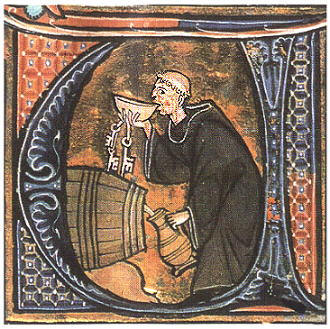
Another
recent white Burgundy highlight came
at Eric Ripert’s new Philadelphia restaurant 10 Arts, where Southern
Wine and Spirits recently held a lunch featuring Louis Latour’s 2006
Burgundies,
both red and white. This always seems like the best way to get to know
a wine: At the table, enjoyed alongside a dish prepared
with that particular bottling in mind. All my tasting notes, however,
were taken before I tucked into the food: Tasting is one thing;
enjoying is often another experience entirely. Fortunately, a lunch
like this provided ample opportunity for both.
The Louis
Latour Meursault-Blagny 1er Cru
“Chateau de Blagny” 2006 is a bit more giving than the Morey.
Not
better or worse, mind you; just different. Its texture is heavier and
more creamy, with an appealingly toasty nose and ripe peaches on the
palate. Despite all this depth, however, it remains surprisingly light
on its feet. Excellent now, but it should continue to improve with
medium-length cellaring. Latour’s Chassagne-Montrachet
2006 is a more
masculine wine, with apparent vanilla, peaches, lemon rind, and a
subtle waxiness. There’s a solid core of minerality here that carries
through to the finish, and enough acid to keep it all fresh and
balanced. Slightly longer cellaring will benefit this one, too.
Then, finally, there was the Louis Latour Corton-Charlemagne Grand Cru 2006,
a linear, fabulously structured wine
that shows exactly what sets the region’s Grand Cru vineyards apart.
The sense of density here, the profound concentration, promise years of
evolution. But with the right food, like the rich, subtle dishes
prepared by chef de cuisine Jennifer Carroll, the wine can be enjoyed
even at this stage of its life; the grated lemon and brown butter
character make it difficult not to pop the cork right now.
Michel Véniat, the Commercial Director for
Maison Louis Latour, said at the lunch, “The Grand Cru in
Burgundy is a miracle.” I’d take it a step further: The land itself in
Burgundy is miraculous. And its ability to make itself known in often
profoundly different ways, through the grapes that grow on its
vineyards, is one of the great gifts of our long-ago wine history,
manifested in the bottlings we enjoy today.
Brian
Freedman is food and
wine editor of LifeStyle Magazine (www.lsmagonline.com),
restaurant critic for AroundPhilly.com and AroundAC.com, director
of wine education at the Wine School of Philadelphia and editorial
director at ClassicWines.com.
CHE STUPIDO!
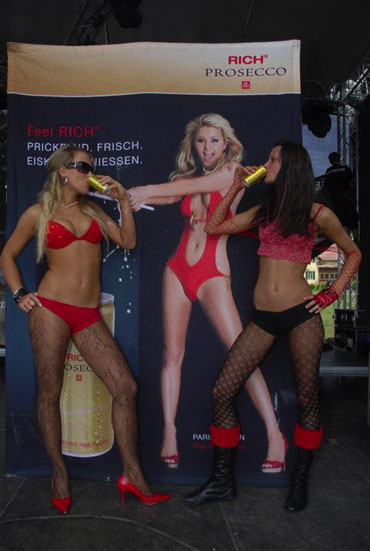
Italian prosecco wine producers are not happy with
an Australian company’s new Rich Prosecco in cans,
using photos of Paris Hilton in its promotion.
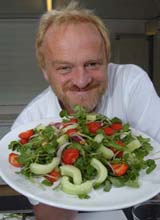 OOPSY!
OOPSY!
After London celeb chef Antony Worrall Thompson (left) recommended the weed henbane as “great in salads,” the magazine Healthy & Organic Living pointed out that you could die from eating it, causing “a loss of consciousness, seizures, trembling of the limbs, and, in extreme cases, death.” The magazine suggested Thompson must have meant the herb fat hen.
QUICK BYTES
TO ALL PUBLICISTS: Owing to the amount of material sent to this newsletter regarding Christmas and New Year's dinners--many of which are only announcements as to price fixed dinners--it is impossible for me to include any but the most unusual of events for those holidays in Quick Bytes. --John Mariani
* In Dallas Lavendou is offering a Menu d’Alsatian incl. specialties from choucroute to tarte aux mirabelles, at $34.95 pp. Lavendou also serves French High Tea by reservation and offers French cooking classes each season. Call 972-248-1911; www.lavendou.com.
* From Jan. 14-19 the 1st Annual Cabo Wine & Food Fest 2009 will be held at Pueblo Bonito Oceanfront Resorts and Spas, with Mexico's Champion Sommelier Juan Carlos Flores. www.cabowineandfoodfest.com.
~~~~~~~~~~~~~~~~~~~~~~
Everett Potter's Travel Report:

~~~~~~~~~~~~~~~~~~~~~~~~~~~~~~~~~~~~~~~~~~~~~~~~~~~~~~~~~~~~~~~~~~~~~~~~~~
Eating Las Vegas is the new on-line site for Virtual Gourmet contributor John A. Curtas., who since 1995 has been commenting on the Las Vegas food scene and reviewing restaurants for Nevada Public Radio. He is also the restaurant critic for KLAS TV, Channel 8 in Las Vegas, and his past reviews can be accessed at KNPR.org. Click on the logo below to go directly to his site.
~~~~~~~~~~~~~~~~~~~~~~~~~~~~~~~~~~~~~~~~~~~~~~~~~~~~~~~~~~~~~~~~~~~~~~~~~~~
Tennis Resorts Online: A Critical Guide to the World's Best Tennis Resorts and Tennis Camps, published by ROGER COX, who has spent more than two decades writing about tennis travel, including a 17-year stretch for Tennis magazine. He has also written for Arthur Frommer's Budget Travel, New York Magazine, Travel & Leisure, Esquire, Money, USTA Magazine, Men's Journal, and The Robb Report. He has authored two books-The World's Best Tennis Vacations (Stephen Greene Press/Viking Penguin, 1990) and The Best Places to Stay in the Rockies (Houghton Mifflin, 1992 & 1994), and the Melbourne (Australia) chapter to the Wall Street Journal Business Guide to Cities of the Pacific Rim (Fodor's Travel Guides, 1991). THIS WEEK: A Report on The Four Seasons Jackson Hole. Click on the logo below to go to the site.

Family Travel
Forum: The
Family Travel Forum (FTF), whose motto is "Have Kids, Still Travel!",
is dedicated to the ideals, promotion and support of travel with
children. Founded by business professionals John Manton and Kyle
McCarthy with first class travel industry credentials and global family
travel experience, the independent, family-supported FTF will provide
its members with honest, unbiased information, informed advice and
practical tips; all designed to make traveling a rewarding, healthy,
safe, better value and hassle-free experience for adults and children
who journey together. Membership in FTF will lead you to new worlds of
adventure, fun and learning. Join the movement.
All You Need to Know Before You Go
~~~~~~~~~~~~~~~~~~~~~~~~~~~~~~~~~~~~~~~~~~~~~~~~~~~~~~~~~~~~~~~~~~~~~~~~~
MARIANI'S VIRTUAL GOURMET NEWSLETTER is published weekly. Editor/Publisher: John Mariani.
Contributing Writers: Robert Mariani,
John A. Curtas, Edward Brivio, Mort
Hochstein, Suzanne Wright, and Brian Freedman. Contributing
Photographers: Galina Stepanoff-Dargery, Bobby Pirillo. Technical
Advisor: Gerry McLoughlin.
Any of John Mariani's books below
may be ordered from amazon.com by clicking on the cover image.
 My
newest book, written with my brother Robert Mariani, is a memoir of our
years growing up in the My
newest book, written with my brother Robert Mariani, is a memoir of our
years growing up in the For those of you who don't think of the Robert and I think you'll enjoy this very personal look at our --John Mariani |
 |
 |
 |
 |
 |
 |
© copyright John Mariani 2008
